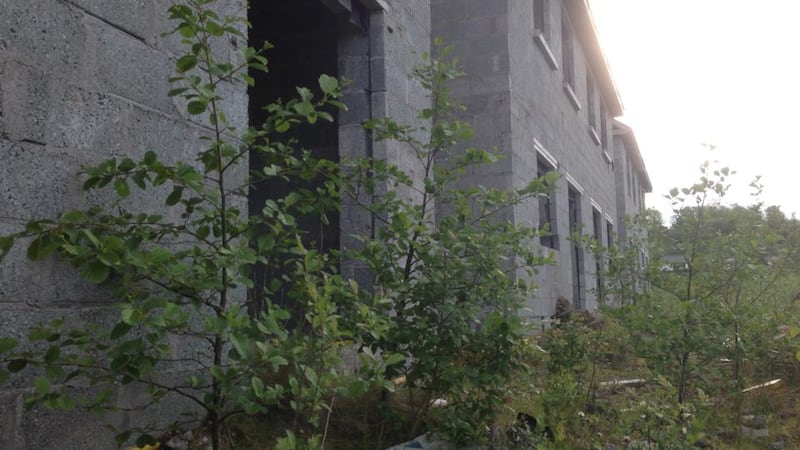We rose before sunrise, a consternation of alarm clocks calling us to action. The first glitch appeared when the motor on the boat to ferry us across the lake stubbornly refused to start.
Most of the group of about 20 would have to proceed by car. I enthusiastically volunteered to row the short distance in a smaller vessel blithely ignoring my complete inability to maintain a steady stroke. Fortunately my companion could and the reduced armada meandered unsteadily in the pale dawn.
The remote village of Keshcarrigan in Co Leitrim did not seem to notice the small cavalcade bringing hundreds of saplings through the gates of the notorious “Waterways” ghost estate. Posters outside projected a vision of happy families cavorting on blissful summer days. The reality was an eerie scrapheap of unfinished houses and shattered dreams.

Over the course of the day we planted nearly a thousand mainly native tree varieties. But we had not gone unnoticed. A police van trundled through the gates. As a trained barrister, I agreed to plead our case. I told them we were asserting the right of a community to plant trees on common land fallen into disrepair.
Charm of protest
The site of famished hardcore and errant Styrofoam abetted the argument but really I think the constabulary found the charming smiles of the female conspirators more persuasive. Observing this wasn’t a cut-throat bunch of
sans culottes
, they let us carry on.
Three years on, it is astounding to consider the media furore our small action unleashed. Within hours of an online article appearing, the John Murray Show was in touch looking for interviews. We continued with further actions, planting trees on sites in Wicklow near Rathdrum and then Cherrywood, Dublin, where RTÉ news crews turned up.
I was interviewed with a neck tie wrapped around my head. Coated in dust I looked like a cross between a tramp and the Karate Kid. The Irish Times, Independent and Daily Mail featured pictures of us on their front page. It culminated in Serena Brabazon delivering a TED talk at the Bord Gáis Theatre.
We were happy to court publicity and played to the cameras. We chose business suits in imitation of the banking elites that had brought the country to ruin and allowed the landscape to be blighted with unfinished developments.
Nama to Nature’s success can be attributed to the capacity of new media to transform a small action into a much larger spectacle. Online publication and Facebook allowed us to bring images to a wide audience, and mainstream media was attracted by the exotic phenomenon of guerrilla gardening. It also helped that the participants were well-spoken and possessed a sense of humour.
Upbeat activism
What also made Nama to Nature a brief hit was it lifted the national mood in 2012 by offering a novel response to problems that seemed intractable. We showed you could do something quite easily to improve a local environment.
Beyond the burlesque, what we were doing was actually a serious questioning of the inviolability of property rights. We were tentatively identifying grounds under which a right to property might be set aside for the greater good of the community, and even for the sake of the natural environment.
We were saying the tragedy of the Irish commons where tax breaks and lax planning allowed developments with no regard to infrastructure could be challenged and that ownership only stretched so far. Without proposing anarchy, we were asserting that communities hold rights over all property in their vicinity. We were also pointing to a consistent Irish blind spot: the failure of many property owners to protect biodiversity.
Those of us who were involved in Nama to Nature are hopeful attitudes to the environment are changing and there is a growing appreciation of the intrinsic value of biodiversity. But shockingly, three years later, as with many such eyesores around the country, nothing has been done to clean the Waterways site. Many of the trees are growing, but substantial debris needs to be cleared.
It beggars belief a State so keen to promote tourism through images of natural beauty allows such grotesque edifices to endure. It demands a response from county councils, and if they fail to act the government must step in.
Longer term, we should anticipate problems before they materialise: just as tax breaks and lax planning allowed the property bubble to develop, today a lack of restraint on farming with the end of milk quotas is set to cause damage to Irish biodiversity and increase our greenhouse gas emissions.
The popularity of Nama to Nature attested to a deep attachment to nature and an awareness that over time and during the Celtic Tiger we paid insufficient attention to it. But the blight of unfinished estates reveals the ghosts that remain in our midst.
Frank Armstrong is a freelance journalist who became involved with Nama to Nature in 2012 facebook.com/namatonature










